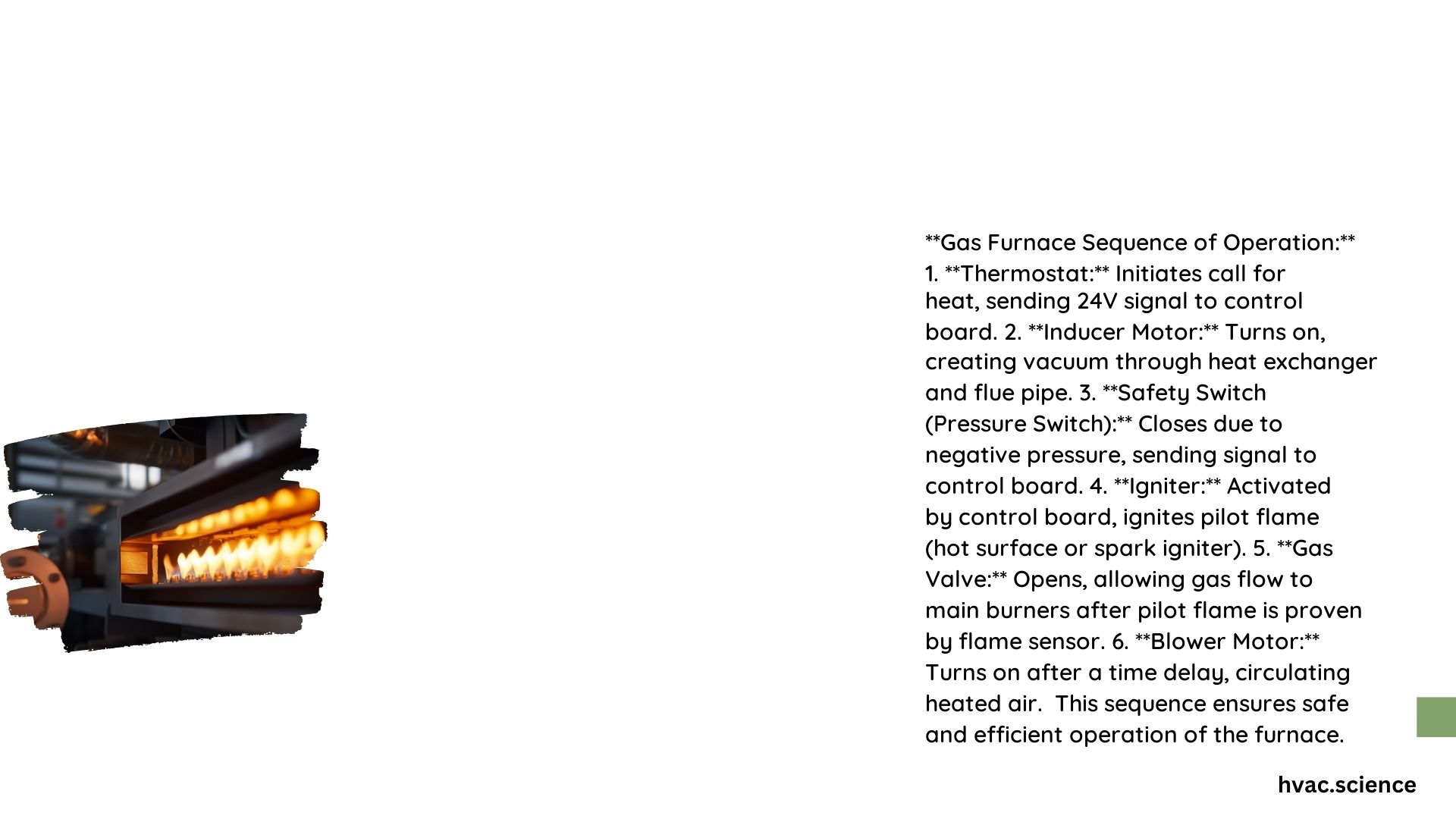The sequence of operation for a gas furnace is a critical series of steps designed to ensure safe and efficient operation. Understanding this sequence is crucial for troubleshooting and maintaining your home’s heating system.
What is the Definition and Key Steps in the Sequence of Operation?
The key steps in the gas furnace sequence of operation are:
- Call for Heat: The thermostat sends a signal to the furnace’s control board, indicating a need for heat.
- Draft Inducer Motor: The control board activates the draft inducer motor, which pulls combustion air into the heat exchanger and aids in venting the exhaust gases.
- Draft Proven: The negative pressure switch (or pressure switch) must be closed to confirm that the inducer motor is creating the necessary draft.
- Igniter Activation: Once the draft is proven, the control board sends a signal to the igniter (which could be a hot surface igniter, pilot, or other type), and the igniter heats up to a high temperature.
- Gas Valve Opening: After the igniter is confirmed to be glowing, the gas valve opens, allowing gas to flow to the burners.
- Flame Proven: The flame sensor verifies that a flame is present before the furnace continues to operate. If no flame is detected, the furnace will shut down.
- Blower Motor Activation: Once the flame is proven, the blower motor turns on, circulating warm air through the ductwork and into the house.
How to Troubleshoot Gas Furnace Issues?

Understanding the sequence of operation is vital for troubleshooting gas furnace issues. Here are some key components and how they relate to troubleshooting:
What are the Issues with Ignition Systems?
Issues with the igniter or pilot can prevent the furnace from lighting. Troubleshooting involves checking the igniter for proper function and ensuring the gas valve is opening correctly.
What are the Problems in the Combustion Cycle?
Problems in the combustion cycle, such as improper draft or flame failure, can lead to furnace shutdown. Verifying that the draft inducer and pressure switch are functioning correctly is essential.
What are the Issues with the Heat Exchanger?
Issues with the heat exchanger, such as cracks or blockages, can affect the furnace’s ability to heat efficiently. Inspecting the heat exchanger and ensuring proper venting is crucial.
What are the Issues with the Blower Motor?
The blower motor’s operation can indicate issues with the furnace’s electrical system or thermostat. Checking the blower motor’s wiring and connections is part of the troubleshooting process.
What is the Function of Pressure Switch and Inducer Motor?
What is the Function of the Pressure Switch?
The pressure switch is a safety device that ensures the draft inducer motor is creating sufficient negative pressure before allowing the furnace to proceed with the ignition sequence. If the pressure switch does not close, the furnace will not ignite, preventing potential safety hazards.
What is the Function of the Inducer Motor?
The inducer motor is responsible for creating the necessary draft to vent combustion gases safely. It starts before the ignition sequence to ensure proper venting and is monitored by the pressure switch to confirm its operation.
How Does the Ignition System Process Work?
The ignition system involves several steps to ensure safe and reliable operation:
- Igniter Activation: The igniter is activated by the control board after the draft is proven. It heats up to a high temperature to ignite the gas when the gas valve opens.
- Gas Valve Opening: The gas valve opens only after the igniter is confirmed to be glowing, ensuring that the gas will be ignited immediately upon release.
- Flame Proven: The flame sensor verifies that a flame is present, and if not, the furnace will shut down to prevent gas accumulation.
How Does the Blower Motor Operation Work?
In some gas furnaces, the blower motor may turn on temporarily right after the inducer motor to help in the initial venting process or to ensure that the system is clear of any residual gases. This is part of the safety protocol to ensure that the furnace operates efficiently and safely.
What is the Sequence of Operation for a 2-Stage Gas Furnace?
A 2-stage gas furnace differs from a single-stage system in that it has two levels of heat output:
- Low Fire: The furnace operates at a lower capacity during mild weather, which can improve efficiency and reduce wear on the system.
- High Fire: During colder weather, the furnace switches to a higher capacity to provide more heat. The sequence of operation remains largely the same, but the control board adjusts the gas flow and burner operation to achieve the different stages.
What are the Technical Details and Troubleshooting Methods?
- Measurements and Timings: The exact timings and measurements can vary depending on the furnace model and manufacturer. However, typical delays include a few seconds for the igniter to heat up and for the gas valve to open after the igniter is confirmed to be glowing.
- Specifications: Understanding the specific specifications of the furnace, such as the type of ignition system and the configuration of the safety switches, is crucial for effective troubleshooting. Referencing the manufacturer’s service manual is often necessary.
References
- Red Deer Heating & AC: “The Sequence of Operations of Gas Furnace” – This article provides a detailed explanation of the sequence of operation, including safety protocols and component functions.
- Quizlet: “Gas furnace sequence of operation Flashcards” – This resource outlines the key steps in the sequence of operation and can be useful for quick reference.
- HVAC Furnace Sequence Of Operation – YouTube: This video explains the sequence of operation in detail, including the roles of major components and troubleshooting tips.
